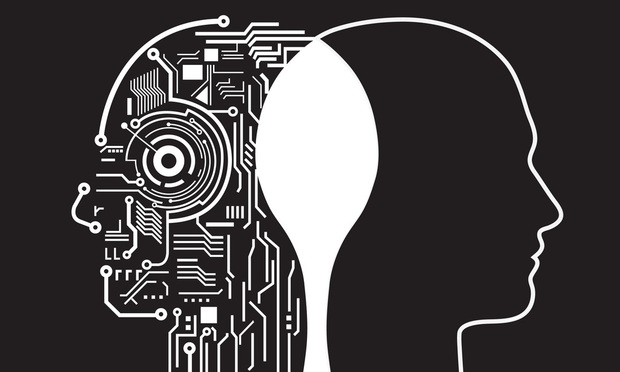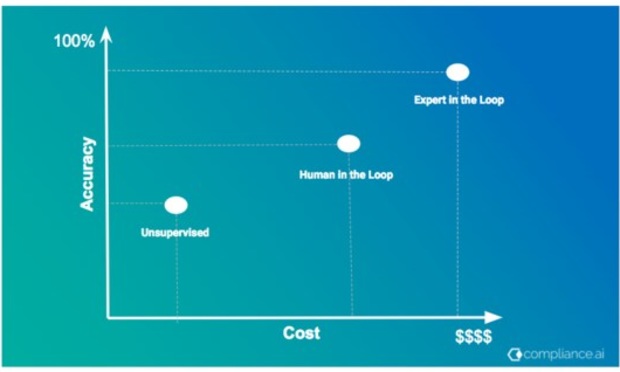3 Reasons Why AI Requires an Essential Human Component in RegTech
In the best interest of accurate data, enlisting a team of industry or topic-focused experts will give the AI the direction it needs to better analyze and classify data.
May 23, 2018 at 08:00 AM
1 minute read
 make it smarter human contributors 1. The evolving and complex nature of regulation is a tough subject matter to master. 2. Expert-in-the-Loop takes Human-in-the-Loop to another level 3. Expert-in-the-Loop models are proportionally more accurate
make it smarter human contributors 1. The evolving and complex nature of regulation is a tough subject matter to master. 2. Expert-in-the-Loop takes Human-in-the-Loop to another level 3. Expert-in-the-Loop models are proportionally more accurate  With more than 25 years of experience in hi-tech, Kayvan leads operations, strategy, sales, and marketing for Compliance.ai. Most recently, Kayvan led the identity strategy at RSA, and represented EMC on various industry alliances such as the FIDO board. He is Co-Founder and CEO of PassBan (acquired by RSA), a company focused on mobile identity assurance. Kayvan also led strategy at LiteScape (as CTO and later as CEO), creating security and mobile identity solutions for VOIP based networks. He was Co-Founder and CTO at BeNotified, a cloud mobile communication service provider.
With more than 25 years of experience in hi-tech, Kayvan leads operations, strategy, sales, and marketing for Compliance.ai. Most recently, Kayvan led the identity strategy at RSA, and represented EMC on various industry alliances such as the FIDO board. He is Co-Founder and CEO of PassBan (acquired by RSA), a company focused on mobile identity assurance. Kayvan also led strategy at LiteScape (as CTO and later as CEO), creating security and mobile identity solutions for VOIP based networks. He was Co-Founder and CTO at BeNotified, a cloud mobile communication service provider. This content has been archived. It is available through our partners, LexisNexis® and Bloomberg Law.
To view this content, please continue to their sites.
Not a Lexis Subscriber?
Subscribe Now
Not a Bloomberg Law Subscriber?
Subscribe Now
NOT FOR REPRINT
© 2025 ALM Global, LLC, All Rights Reserved. Request academic re-use from www.copyright.com. All other uses, submit a request to [email protected]. For more information visit Asset & Logo Licensing.
You Might Like
View AllTrending Stories
Who Got The Work
J. Brugh Lower of Gibbons has entered an appearance for industrial equipment supplier Devco Corporation in a pending trademark infringement lawsuit. The suit, accusing the defendant of selling knock-off Graco products, was filed Dec. 18 in New Jersey District Court by Rivkin Radler on behalf of Graco Inc. and Graco Minnesota. The case, assigned to U.S. District Judge Zahid N. Quraishi, is 3:24-cv-11294, Graco Inc. et al v. Devco Corporation.
Who Got The Work
Rebecca Maller-Stein and Kent A. Yalowitz of Arnold & Porter Kaye Scholer have entered their appearances for Hanaco Venture Capital and its executives, Lior Prosor and David Frankel, in a pending securities lawsuit. The action, filed on Dec. 24 in New York Southern District Court by Zell, Aron & Co. on behalf of Goldeneye Advisors, accuses the defendants of negligently and fraudulently managing the plaintiff's $1 million investment. The case, assigned to U.S. District Judge Vernon S. Broderick, is 1:24-cv-09918, Goldeneye Advisors, LLC v. Hanaco Venture Capital, Ltd. et al.
Who Got The Work
Attorneys from A&O Shearman has stepped in as defense counsel for Toronto-Dominion Bank and other defendants in a pending securities class action. The suit, filed Dec. 11 in New York Southern District Court by Bleichmar Fonti & Auld, accuses the defendants of concealing the bank's 'pervasive' deficiencies in regards to its compliance with the Bank Secrecy Act and the quality of its anti-money laundering controls. The case, assigned to U.S. District Judge Arun Subramanian, is 1:24-cv-09445, Gonzalez v. The Toronto-Dominion Bank et al.
Who Got The Work
Crown Castle International, a Pennsylvania company providing shared communications infrastructure, has turned to Luke D. Wolf of Gordon Rees Scully Mansukhani to fend off a pending breach-of-contract lawsuit. The court action, filed Nov. 25 in Michigan Eastern District Court by Hooper Hathaway PC on behalf of The Town Residences LLC, accuses Crown Castle of failing to transfer approximately $30,000 in utility payments from T-Mobile in breach of a roof-top lease and assignment agreement. The case, assigned to U.S. District Judge Susan K. Declercq, is 2:24-cv-13131, The Town Residences LLC v. T-Mobile US, Inc. et al.
Who Got The Work
Wilfred P. Coronato and Daniel M. Schwartz of McCarter & English have stepped in as defense counsel to Electrolux Home Products Inc. in a pending product liability lawsuit. The court action, filed Nov. 26 in New York Eastern District Court by Poulos Lopiccolo PC and Nagel Rice LLP on behalf of David Stern, alleges that the defendant's refrigerators’ drawers and shelving repeatedly break and fall apart within months after purchase. The case, assigned to U.S. District Judge Joan M. Azrack, is 2:24-cv-08204, Stern v. Electrolux Home Products, Inc.
Featured Firms
Law Offices of Gary Martin Hays & Associates, P.C.
(470) 294-1674
Law Offices of Mark E. Salomone
(857) 444-6468
Smith & Hassler
(713) 739-1250






